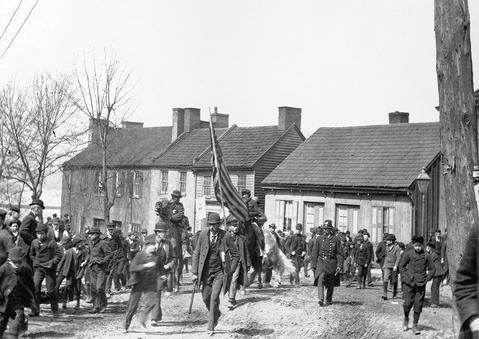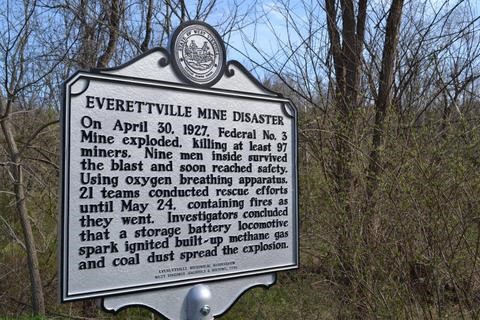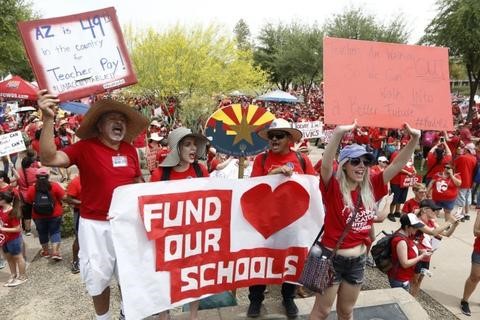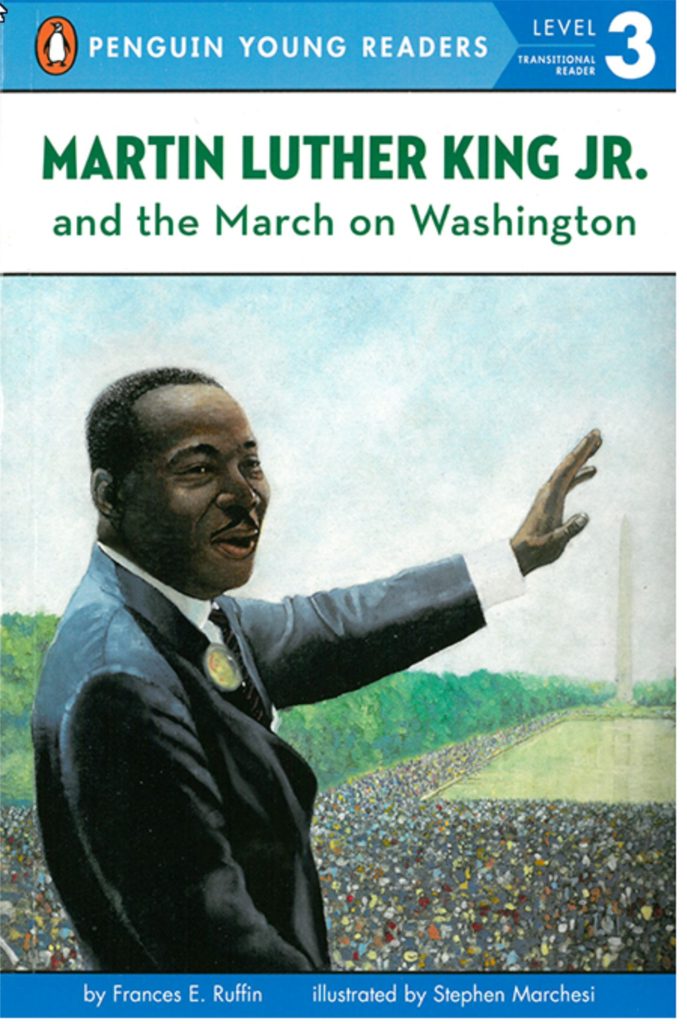April 29
Coxey’s Army of 500 unemployed civil war veterans reaches Washington, D.C. – 1894
An estimated one thousand silver miners, angry over low wages, the firing of union members and the planting of spies in their ranks by mineowners, seize a train, load it with 3,000 pounds of dynamite, and blow up the mill at the Bunker Hill mine in Wardner, Idaho – 1899
The special representative of the National War Labor Board issues a report, “Retroactive Date for Women’s Pay Adjustments,” setting forth provisions for wage rates for women working in war industries who were asking for equal pay. Women a year earlier had demanded equal pay for comparable work as that done by men – 1943
April 30
An explosion at the Everettville mine in Everettville, W. Va., kills 109 miners, many of whom lie in unmarked graves to this day – 1927
The Obama administration’s National Labor Relations Board implements new rules to speed up unionization elections. The new rules are largely seen as a counter to employer manipulation of the law to prevent workers from unionizing – 2012
May 01
Mary Harris “Mother” Jones born in County Cork, Ireland – 1830
Cigar makers in Cincinnati warn there could be a strike in the fall if factory owners continue to insist that they pay 30¢ per month for gas heat provided at work during mornings and evenings – 1883
Eight-hour day demonstration in Chicago and other cities begins tradition of May Day as international labor holiday – 1886
The Cooks’ and Waiters’ Union strikes in San Francisco, demanding one day of rest per week, a 10-hour work day and a union shop for all restaurants in the city – 1901
Mother Jones’ 100th birthday celebrated at the Burgess Farm in Adelphi, Md. She died six months later – 1930
New York City’s Empire State Building officially opens. Construction involved 3,400 workers, mostly immigrants from Europe, and hundreds of Mohawk iron workers. Five workers died during construction – 1931
Congress enacts amendments to the 1938 Fair Labor Standards Act, extending protections to the employees of state and local governments—protections which didn’t take effect until 1985 because of court challenges and regulation-writing problems – 1974
The federal minimum wage rises to $2 per hour – 1974
Int’l Molders & Allied Workers Union merges with Glass, Molders, Pottery, Plastics & Allied Workers Int’l Union – 1988
Woodworkers of America Int’l merges with Int’l Association of Machinists & Aerospace Workers – 1994
Int’l Leather Goods, Plastics & Novelty Workers Union merges with Service Employees Int’l Union – 1996
Rallies in cities across the U.S. for what organizers call “A Day Without Immigrants.” An estimated 100,000 immigrants and sympathizers gathered in San Jose, Calif., 200,000 in New York, 400,000 each in Chicago and Los Angeles. In all, there were demonstrations in at least 50 cities – 2006
May 02
Chicago’s first Trades Assembly, formed three years earlier, sponsors a general strike by thousands of workers to enforce the state’s new 8-hour-day law. The one-week strike was unsuccessful – 1867
Birth of Richard Trevellick, a ship carpenter, founder of American National Labor Union and later head of the National Labor Congress, America’s first national labor organization – 1830
First Workers’ Compensation law in U.S. enacted, in Wisconsin – 1911
President Herbert Hoover declares that the stock market crash six months earlier was just a “temporary setback” and the economy would soon bounce back. In fact, the Great Depression was to continue and worsen for several more years – 1930
German police units occupied all trade unions headquarters in the country, arresting union officials and leaders. Their treasuries were confiscated and the unions abolished. Hitler announced that the German Labour Front, headed by his appointee, would replace all unions and look after the working class – 1933
A fire at the Sunshine silver mine in Kellogg, Idaho, caused the death of 91 workers who died from carbon monoxide poisoning, likely caused by toxic fumes emitted by burning polyurethane foam, used as a fire retardant – 1972
May 03
Four striking workers are killed, at least 200 wounded, when police attack a demonstration on Chicago’s south side at the McCormick Harvesting Machine plant. The Haymarket Massacre is to take place the following day – 1886
Eugene V. Debs and other leaders of the American Railway Union are jailed for six months for contempt of court in connection with Pullman railroad car strike – 1895
Pete Seeger, folksinger and union activist, born in Patterson, N.Y. Among his songs: “If I Had A Hammer” and “Turn, Turn, Turn” – 1919
May 04
Haymarket massacre. A bomb is thrown as Chicago police start to break up a rally for strikers at the McCormick Harvesting Machine Co. A riot erupts, 11 police and strikers die, mostly from gunfire, and scores more are injured – 1886
May 05
National Typographical Union founded, Cincinnati, Ohio. It was renamed the Int’l Typographical Union in 1869, in acknowledgment of Canadian members. When the ITU merged into CWA in 1986 it was the oldest existing union in the U.S. – 1852
On Chicago’s West Side, police attack Jewish workers as they try to march into the Loop to protest slum conditions – 1886
Some 14,000 building trades workers and laborers, demanding an 8-hour work day, gather at the Milwaukee Iron Co. rolling mill in Bay View, Wisc. When they approach the mill they are fired on by 250 National Guardsmen under orders from the governor to shoot to kill. Seven die, including a 13-year-old boy – 1886
Nineteen machinists working for the East Tennessee, Virginia, and Georgia Railroad gather in a locomotive pit to decide what to do about a wage cut. They vote to form a union, which later became the Int’l Association of Machinists – 1888
Italian-American anarchists Nicola Sacco and Bartolomeo Vanzetti are arrested in Boston for murder and payroll robbery. Eventually they are executed for a crime most believe they did not commit – 1920
Heavily armed deputies and other mine owner hirelings attack striking miners in Harlan County, Ky., starting the Battle of Harlan County – 1931
John J. Sweeney, president of the Service Employees Int’l Union from 1980 to 1995, then president of the AFL-CIO from 1995 to 2009, born in the Bronx, N.Y. – 1934
Lumber strike begins in Pacific Northwest, will involve 40,000 workers by the time victory is achieved after 13 weeks: union recognition, a 50¢-per-hour minimum wage and an 8-hour day – 1937
The U.S. unemployment rate drops to a 30-year low of 3.9 percent; the rate for Blacks and Hispanics is the lowest ever since the government started tracking such data – 2000
Capping several weeks of teacher unrest across the country, public educators in Arizona win raises of 10 to 20 percent following a week-long strike; Oklahoma teachers shortly before that struck for nine days and won roughly $6,000 in annual increases, while the teachers who started it all, in West Virginia, won a 5 percent raise after their nearly two-week walkout – 2018
-Compiled and edited by David Prosten.
|










